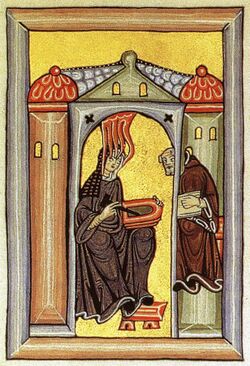Religion:Equivalent canonization

Equivalent canonization or equipollent canonization (Latin: equipollens canonizatio) is a form of canonization that occurs when the Pope recognizes and orders the public and universal veneration of a Servant of God, without having gone through the procedure normally required by formal canonization, because veneration of the saint has been carried out since ancient times and continuously by the Church.
History
Veneration of martyrs and saints are attested from the first centuries of the Church. However, canonization as an ecclesiastical procedure was not outlined until the 11th century with the aim of seeking to define those Christians who would deserve the universal reverence of the Church, thus avoiding confusion between local churches and seeking that the virtues of the deceased were fully proven. Already during this time the authority of the pope was appealed to claim to him or to the synods the power to determine said cult.[1]
In the 17th century, Pope Urban VIII began to make pontifical declarations of canonization through papal bulls, the first canonized saints being Philip Neri, Ignatius of Loyola, Francis Xavier, and in other bulls he would decree the beatification of other servants of God. Similarly, in 1634, through the bull Caelestis Hierusalem cives, he established such powers of beatification and canonization as exclusive to the Holy See.[2]
In the first half of the 18th century, Bishop Prospero Lambertini, before being elected as pope under the name of Benedict XIV, published his maximum liturgical work entitled De servorum Dei beatificatione et de beatorum canonizatione, where he expounded the doctrine of "equivalent canonization" and described the possibility of establishing public veneration for a person whose reputation for holiness and heroic virtue has long been proven by tradition and for whom there was already a prior veneration in the Church.
This doctrine has been reiterated since then by various pontiffs up to modernity without the most recent provisions regarding the canonization process having repealed it as a valid practice, exclusive to the Pope.
Various saints have been included in the martyrology in this way, including Romuald, Norbert of Xanten, Bruno of Cologne, Peter Nolasco, Raymond Nonnatus, John of Matha, Felix of Valois, Margaret of Scotland, Stephen I of Hungary, and Pope Gregory VII.[1] Some of the most recent cases of equivalent canonization were that of Hildegard of Bingen on 10 May 2012, 833 years after her death;[3] that of Angela of Foligno on 9 October 2013, 704 years after her death;[4] that of Peter Faber on 17 December 2013, 467 years after his death; and that of Joseph of Anchieta on 3 April 2014, 416 years after his death.
Requirements
Unlike the ordinary canonization, in which a whole canonical process is necessary, in equivalent canonization only the prior verification of public veneration of the servant of God carried out historically and without interruption, the fame of holiness and miraculous intercession and heroic virtues or martyrdom.
After the above, only a public declaration of the Supreme Pontiff is enough where the extension of the cult of the saint to the Universal Church is ordered.
Complete list

As examples, prior to his pontificate, of this mode of canonization, Pope Benedict XIV himself enumerated the equipollent canonizations of saints:
- Romuald - 9 July 1595
- Norbert - 7 September 1621
- Bruno - 6 October 1623
- Pope Gregory VII - 25 September 1728
- Duke Wenceslaus of Bohemia - 14 March 1729
- Gertrude of Helfta - 20 July 1738
Later equipollent canonizations include those of saints:
- Peter Damian - 1 October 1828
- Vibiana - February 1854
- Cyril and Methodius - 30 September 1880
- Cyril of Alexandria - 28 July 1882
- Cyril of Jerusalem - 28 July 1882
- Justin Martyr - 28 July 1882
- Augustine of Canterbury - 28 July 1882
- John of Damascus - 29 August 1890
- Sylvester Gozzolini - 29 August 1890
- Bede the Venerable - 25 May 1899
- Ephrem the Syrian - 5 October 1920
- Albert the Great - 15 December 1931
- John Fisher - 19 May 1935
- Thomas More - 19 May 1935
- Gregorio Barbarigo - 26 May 1960
- Meinhard of Livonia - 8 September 1993
- Hildegard of Bingen - 10 May 2012
Pope Francis added saints:
- Angela of Foligno[5] - 9 October 2013
- Peter Faber - 17 December 2013
- Joseph of Anchieta - 3 April 2014[6][7]
- Marie of the Incarnation - 3 April 2014[7]
- François de Laval - 3 April 2014[7]
- Joseph Vaz - 14 January 2015
- Bartholomew of Braga - 5 July 2019
- Margaret of Castello - 24 April 2021
References
- ↑ 1.0 1.1 "Beatification and Canonization" (in en). Catholic Encyclopedia. 1907. http://www.newadvent.org/cathen/02364b.htm. Retrieved 11 May 2012.
- ↑ "Pope Urban VIII" (in en). Catholic Encyclopedia. XV. 1912. http://www.newadvent.org/cathen/15218b.htm. Retrieved 11 May 2021.
- ↑ "Una gran intelectual". L'Osservatore Romano. 12 May 2012. http://www.osservatoreromano.va/portal/dt?JSPTabContainer.setSelected=JSPTabContainer%2FDetail&last=false=&path=/news/editoriali/2012/109q12-Un-grande-intellettuale.html.
- ↑ "La canonización equivalente de la mística Ángela de Foligno". L'Osservatore Romano. 12 October 2013. http://www.news.va/es/news/la-canonizacion-equivalente-de-la-mistica-angela-d.
- ↑ Angelo Amato, "La canonizzazione equipollente della mistica Angela da Foligno" in L'Osservatore Romano (12 October 2013).
- ↑ "Pope Canonizes Jose de Anchieta, Known as Brazil's Apostle". Fox News Latino. http://latino.foxnews.com/latino/news/2014/04/03/pope-canonizes-jose-de-anchieta-known-as-brazil-apostle.
- ↑ 7.0 7.1 7.2 Wooden, Cindy (3 April 2014). "Pope declares by decree three new saints for the Americas". Catholic News Service. http://www.catholicnews.com/data/stories/cns/1401370.htm.
 |

